
CHART
BOX
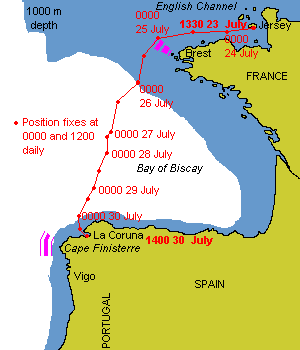
© Copyright 1999 Nigel Jones/MistWeb Software

 |
CHART |

|
|
| Sketch Maps and Chartlets (not to be used for navigation!) © Copyright 1999 Nigel Jones/MistWeb Software |
|
It was getting dark on Thursday 29th July, our sixth day at sea. There was a big swell running. The Météo-France forecast on the Navtext was calling it a 2 m swell and it was all of this. A big swell like this is no problem to a small boat, it is just like sailing uphill for a while then down again. If you are not looking you would not notice it.
Nicky was looking over the bow and thought she caught a glimpse of a light. She looked hard, thinking it to be a distant ship that we might have to avoid. There was nothing. Hidden in the swell, she thought, waiting for us and it to be lifted up at the same time again. Then off to port she saw it again. How did he get right over there? she wondered.
Then she realised: These lights were lighthouses. It was not just the swell, these were flashing lights... She had seen on the chart that there are many lighthouses along this North coast of Spain, and now here they were. Tiny pin-pricks in the dark horizon, coming and going, flashing on and off.
"This coast is ringed with lights, look!" she said to me.
"Wow! We're there!" I replied, peering into the gloom.
"Well, I wouldn't start getting the fenders out just yet, but that is certainly land ahead," she joked. I have been known to have the boat ready for harbour with 5 miles to go in my early days at sea. This time we still had 30 miles ahead of us.
The forecast was north-east force 3 - 4 locally 5, mist, sea slight with a 2 m swell. It looked like perfect weather for our landfall, as long as the mist did not become a problem. It was important to identify these lights as quickly as possible, in case they disappeared.
Out came the stop-watch and I began counting the flash-patterns and timing the repetition period, calling my results down to Nicky who was searching the chart for matches. The one we were interested in was the 105 m high light on Cabo Prior. Its pattern was quoted as one flash, then two, repeating every 15 seconds. I found one with three flashes, perhaps there was a longer delay between the first two than the second, repeating every 14 seconds. We scoured the chart to find one that we could be muddling with Cabo Prior, but found nothing else that was closer to what we were seeing.
At 2200 I plotted our GPS position on the chart and crossed it with a bearing line on our Cabo Prior light. The match was within half a mile - not bad considering the 16-mile range to this light at the time. At 2300 I repeated this and the bearing line came within 0.2 NM of the GPS position. I was now fairly confident of our landfall. By 0100 and 0200 I was getting exact agreement of the compass-bearing of this light and the GPS plots on the chart.
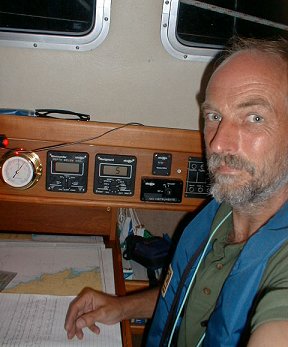 |
| Self-portrait during the long hours of the last night-watch of the trip. The '5' on the instrument behind me is the wind speed: 5 knots, mostly brought on by the swaying of the mast-head anemomenter in the swell. |
At around midnight the quiet of the night was shattered by the arrival of a gang of very puffed and boistrous dolphins. These were full-size ones, 2 - 3 m long, like we're used to seeing around Jersey. The sounded and acted like a pack of dogs out for a run, arriving all around the boat simultaneously and blowing breath in sharp bursts with a good deal of splashing and high-jinks.
I leaned over the stern to talk to them. I asked them if they'd come to guide me and was I coming in alright? One of them replied by grabbing hold of our fishing-net, which was still trailing from the propeller, and giving it a good yank. This rattled the wind-vane steering gear. I began to be alarmed when others joined in and soon quite a squabble was breaking out as to who was going to get the next pull on it. I told them off and then covered our white stern-light with my hand, moving it back and forth to make the light appear to flash on the water surface. They got the message and stopped, but then soon got bored and went off to find a better boat to harrass.
When we later had a good look at the net I wondered if it was the odd mussels still attatched to its weave that had been of interest. The analogy of the dolphins to a pack of dogs seems quite apt. Maybe they are more capable than dogs, but this definitely seemed to be a good way of thinking about them and relating to them that night.
Meanwhile, the wind was dying on me. By 0300 we had run into that equation between the size of the swell and the strength of the wind: The sails had insufficient wind-pressure in them to keep any shape as the big 2-meter swells rolled our keel. We were still doing about one knot, so I did not want to take them down. We needed steerage-way and control as there was an increasing amount of fishing boat traffic passing us in both directions, but they were collapsing and re-filling with some awful bangs.
I now wanted to get there, too, but I was worried in case the shock-load stresses did some damage, or whether the chafe on the sailcloth or stitching would lead to further head-aches down the line. The mast-head navigation light is called a tri-colour as it shows green, red and white light into three appropriate sectors. It had already stopped working during this trip. I still haven't been up there to find out if the bulb has blown or if a wire has come loose. Whichever it is, I am sure that the slatting and banging of big sails when becalmed does not help. There was still the motoring light, the deck-floods, the radar and the TV antenna to go. I did not want to break every electrical connection in the mast. Thankfully, all these others have survived the trip.
At 0530 I wrote in the log, "Moving again - 2 kn." It is amazing how grateful you become for small mercies when you are worrying about all of the above. At 0700 my entry reads, "Becalmed 'again' - or is it 'still'?" Enough wind to sail at a full 3 knots returned at 0830.
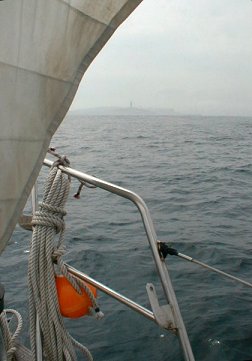 |
| The Torre de Hercules, soon after it appeared out of the mist. Note the trip-line for the anchor stowed half-ready on the pulpit and our rather dirty 10-year-old sails (High-cut yankee jib visible) |
It was light now and I had had a glimpse of the Spanish coast - big and hilly it appeared - but it was lost again in the mist which had stayed with us gently all night. By 1000 we were skirting the shallow Banco de las Laixiñas off Cabo Prior where these monster swells could easily be steepening and breaking. This would be disastrous for a small boat caught in them. As it was, the swells had picked up speed and were towering up behind us before sweeping through. Each one managed to just break the air-flow over our sails enough, at its peak, to cause a bang from the rig - a taunt and a reminder of the havoc they had been able to cause all night.
El Torre de Hercules - the Tower of Hercules - is the oldest lighthouse in the world, having been originally built by the Romans. Not only that, but it is far from a preserved ancient monument, it is still working and is still the principle light outside the Ría de la Coruña, the bay into which we were headed. We sailed towards the old tower for an hour and a half before picking up the leading marks on Pointa de Mera that showed us to be clear of the last shallow, breaking bank in the approaches. We entered the Ría soon after 1200 and started to plan our approach, for it was to be without the benefit of any engine to help us in.
La Coruña harbour is protected from the prevailing North-Easterlies by a long breakwater and has just been left open at the end of this. The forecast had been for North-Easterly winds, and that was what we had behind us as we approached the Ría. I rolled away Rusalka Mist's yankee jib and we proceeded slowly under stays'l and full main as I got the anchor and its trip-line plus buoy ready (the books and charts say that the harbour bed is littered with wrecks which can foul your anchor - the trip line may save the day if this happens: you can pull the anchor out backwards). Rusalka sails well in this configuration. I was expecting to round the breakwater-end and beam-reach along it about 100 m off until we came to the first anchored boat then drop the sails and drop our hook about 100 m short of it.
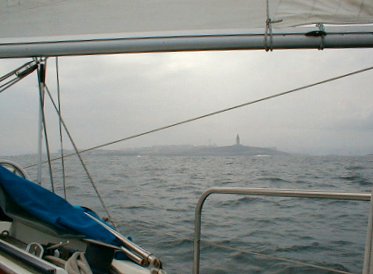 |
| The Tower of Hercules is the oldest lighthouse in the world, started by the Romans and still in use. Our 2-meter swell was smashing itself to spray on the rocks before it. Note preventer on main boom, essential in these conditions. |
As we passed the green light on the end of the pier, I was very surprised that I could not lay a course anywhere close to this. The wind was north-westerly suddenly and the best I could do was skirt the anchored yachts and head for the commercial docks. We had a back-up plan to anchor in their large-ship anchorage and call for assistance if all else failed. Before putting this into operation I decided to try a tack immediately, to see if I - and the boat - could do it in the current conditions.
To my relief, she came about easily and we were gently heading to windward, back out of the harbour. As I tacked back in again, a local sailing school instructor in a RIB decided to herd his fleet of tiny children in microscopic dinghies back around the breakwater's tip. They followed him, all of a dither, like ducklings trying to keep up with mum, while I backed and filled and spilled and drew, waiting for them all to pass, oblivious to any rights of way. We took a swoop across the anchorage, tacked and beat up towards the stone jetty. I left the tiller and called to Nicky to pull down the sails as planned. The anchor was tipped over the bow in a bit of a rush, followed by rather too much chain too quickly. We looked about ourselves and - Damn! - we were much too close to the rough stones. The current wind was holding us off them but, should it change, we would certainly come into contact.
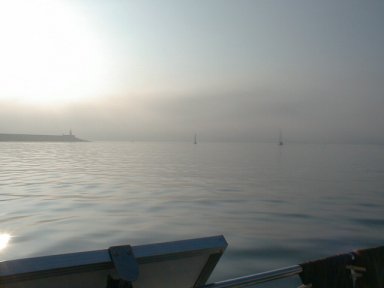 |
| The view of the harbour mouth in the mist of the early morning following our arrival, taken from on board. The trousers I had worn to man-handle that stinking net on board were already washed and hanging out to dry! |
We then had our first row of the trip. Yes, it was my fault and no, I wasn't sure what to do about it, but no, I didn't think that that meant that we shouldn't be here at all or that the whole thing was a mess. This took about 30 minutes including two VHF calls to local coast-stations who spoke perfect English and could not suggest who could be contacted for help, apart from the local yacht-club who did not answer at all.
Mercifully the wind did not back during this time and we were still held off the wall. We had already pumped up the rubber dinghy and were ready either to tow Rusalka if its little 2 hp engine could manage it or to motor ashore and find someone with a more powerful boat. Then we decided to bite the bullet and do the obvious thing. We put up the mainsail - flapping madly in the Force 3 rising to 4 - then I pulled up the anchor with our powerful manual windlass. As soon as it was cock-a-bill we hauled up the stays'l and payed off away from the wall.
This time the pressure seemed to be off me. We sailed around the anchorage carefully but fairly effortlessly, tacking two or three times more and selected our spot, well clear of the wall, just outside most of the other boats. The anchor went down well, Nicky got a sail-tie around the main to prevent it filling once it was hanging from the boom to the deck, and all was quiet at last. It was 1545, we put out 60 m of chain in 16 m of water, and began switching off instruments that had been on for a week. We had logged 660 nautical miles in covering a 510 NM route in a few hours over seven days at sea, mostly without the use of the engine. Our first ocean voyage was over and we put the kettle on.